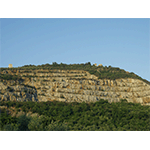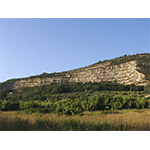Quarries on the hill of Monsummano Terme
The hill of Monsummano Terme is remarkably interesting from the geological and naturalist point of view. It has been studied and described by scientists such as Pier Antonio Micheli, Giovanni Targioni Tozzetti and Alessandro Bicchierai. The latter, in his treatise Dei Bagni di Montecatini [Concerning the Baths of Montecatini] (Florence, 1788), observed that the volcanic origin of the place might in some way be confirmed by the hot springs found there.
In the mountain quarries, various kinds of stones used in construction sites since the Middle Ages were mined. A red alberese, known as red marble, was used for a frieze in the sacristy of Santa Maria Novella and for some slabs of stone in the floor of Santa Maria del Fiore. Red marble was also used in the church of the Madonna dell'Umiltą in Pistoia, while golden travertine was employed in the loggia of the Pilgrims' Lodge at Monsummano.
In 1849 some miners working in a quarry discovered the thermal cavern. The quarries, no longer active since the middle of the 1980s, now form part of a nature reserve. The Museum of the City and Territory of Monsummano has a geology and paleontology section that contains samples of rocks from the hill, as well as documentation on their artistic use in decoration schemes.
****************************
Texts by Graziano Magrini
English translation by Catherine Frost
Last update 28/feb/2008





